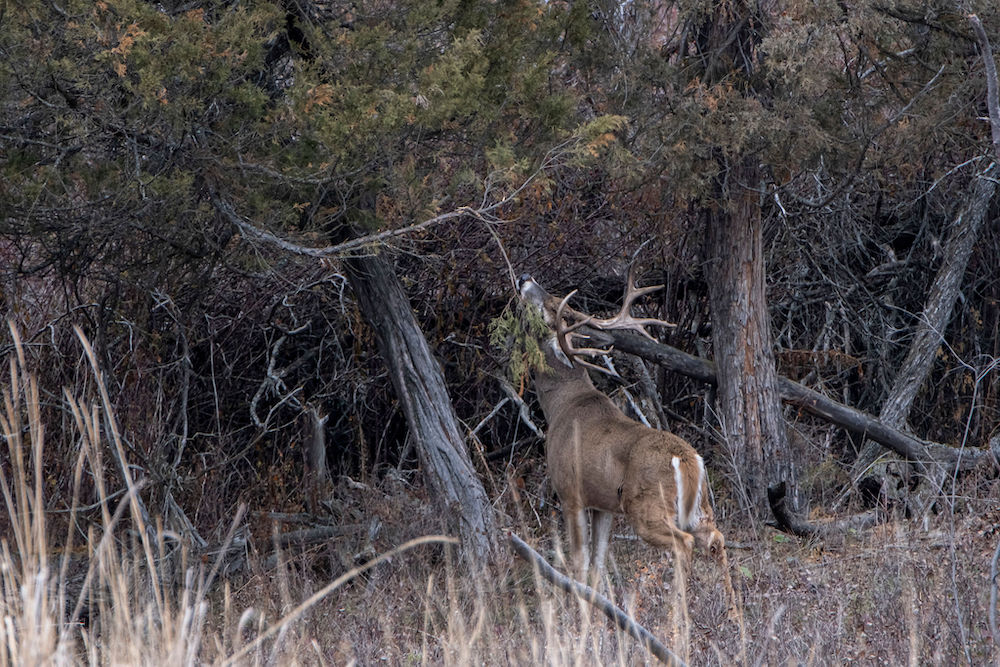Most people spend about a third of their lives asleep, and it’s pretty easy to identify someone’s bedroom in a home. White-tailed deer spend a lot of time in their bedding areas, too, but their beds aren’t as easy to ID as a queen-size mattress. Still, if you can find a bedding area, you’re much closer to intercepting a deer on its bed-to-food travel route — and that’s the fundamental goal when setting up for a bow shot. Let’s dive in to learn what a bedding area is, how to find it and how to hunt it.

A bedding area is a place where deer reside between feeding sessions. Larry McCoy, a bowhunter with 32 years of experience and co-host of Respect the Game TV, said a bedding area is where deer spend most of their days since they feed at night.
“In most cases, deer will bed where they feel safe,” McCoy said. “They look for places that have cover or a canopy, some source of water and something for them to chew on, like green browse, berries or undergrowth. They like places where they can sleep, rest and move around to stretch without being seen.”
Unlike a human who sleeps in the same bed each night, a whitetail might bed in a different spot each time it returns to the area, and they’ll even move around within their bedding area during the day to stretch, browse and defecate.
Bedding areas can be small or large, but they all share two common characteristics: one, they’re usually undisturbed by humans, and two, they provide thick security cover. Bedding areas typically change with the seasons, too. There’s more foliage in the early season, which gives deer more options. As it gets colder and the leaves start to drop, deer will seek refuge in thicker areas.
McCoy has been finding bedding areas and hunting near them for most of his bowhunting career, and he said you’ll know when you’re getting close because there will be a lot of tracks, droppings and other deer sign, including actual depressions on the ground left by bedding deer. An individual deer bed is oval or kidney-bean shaped and about 2 to 3 feet in diameter. They are easy to identify in the snow or tall grass but can be difficult to spot in the forest. Does often bed in family groups, but mature bucks typically bed by themselves during fall hunting seasons.
If you don’t see individual beds, don’t fret. As long as the area is thick and laden with sign, you’re in a likely place.

McCoy said creating a hunt strategy around a bedding area is a highly effective tactic, especially when you’re targeting mature bucks, as long as you do it strategically.
Deer are crepuscular, which means they’re most active at dawn and dusk, and they feed more at night than during the day. Therefore, understanding food sources and how deer use the terrain, in addition to where they bed, helps you dial in on the perfect place to intercept them during shooting light. “Setting up near a bedding area increases your chances of seeing a target deer in daylight,” McCoy said.
McCoy initially scouts for bedding areas in spring using aerial maps and Google Earth. He’ll confirm the area is active and well used by scouting on foot next. When early fall hunting seasons roll around, he hunts food sources near the bedding area, partly because it’s warmer then and deer don’t travel as far, but also because it allows him to pinpoint how deer travel to and from their bedding area to feed.
“I like to sit on a food source (in the evening) to see how deer enter the field,” McCoy said. “If you watch them, they’ll all come in, fan out and move in a similar direction. I’m trying to narrow that gap and identify where they’re coming out. That’s where I want to slip in (the next hunt). It may take me three or four sits to move locations and inch in to where I want to be without being detected.”
McCoy uses a hunting journal to keep track of the day, wind direction and his observations, including where the deer come from and travel to, and what they’re eating or doing. This allows him to look back on his notes and make smart decisions regarding future setups.
If you’re not seeing deer until last light, McCoy said it’s probably because the bedding area is far away and it’s taking the deer a long time to travel to the food. Keep moving closer, but do it slowly and methodically, or you’ll spook the deer.
“Don’t rush it,” he said. “It’s important not to jump right in to where they’re at. I like to hunt 100 yards off the fringes (of the bedding area). If you go in there and bump the deer, they’ll know they’re being hunted and it will be more difficult. You must know how to get in and out quietly, without letting deer know you’re there. Sitting off the trail is important.”
Once you find the perfect spot with a safe, nonintrusive entry and exit path, McCoy said, mark it with night eyes or reflective tape so you can walk directly to your stand without veering off the path and leaving extra scent in the woods. Then, stay awhile.
“Once you’re there, you’re there,” he said. “I recommend sitting there for a whole day. That’s your best chance to catch a buck on his travel route.”
Remember to check the wind and only hunt the spot when the wind is right. If you find the perfect spot but don’t hunt it until midseason, McCoy said, that’s OK. It’s better to save the area and hunt it with the right conditions than it is to risk too much and accidentally bust deer. Hopefully, your research, patience and persistence will pay off with a good, close-range shot opportunity!